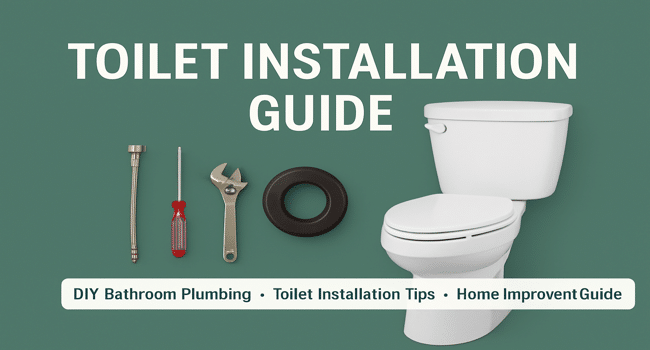Table of Contents
Installing and plumbing a bathroom is a practical home improvement mission that many residence proprietors can cope with themselves. Whether you’re replacing an old rest room or adding one to a modern day bathroom, proper set up ensures green flushing, prevents leaks, and offers long-term reliability. This article will stroll you thru each step of the procedure, from training to trying out.
Tools and Materials You’ll Need
Toilet installation is extraordinarily sincere when you have the right tools and elements on hand:
- New lavatory (bowl and tank)
- Wax ring or rubber seal
- Closet bolts and flange
- Toilet deliver line
- Adjustable wrench
- Screwdriver
- Level
- Bucket and sponge
- Plumber’s putty or silicone caulk
- Towels or rags
- Utility knife (to trim bolt caps)
Step 1: Remove the Old Toilet (If Applicable)
If replacing a rest room, close off the water deliver valve placed behind the rest room close to the floor. Flush the bathroom to empty the tank and bowl. Use a sponge or towel to cast off any remaining water.
Next, disconnect the water deliver line from the tank. Unscrew the nuts securing the bathroom to the ground bolts and lightly rock the rest room from side to side to interrupt the wax seal. Carefully carry the rest room and set it aside on a towel or plastic sheet.
Use a putty knife to scrape away the old wax ring and check out the rest room flange. Make certain it’s smooth and in exact condition. Replace or restore it if it’s cracked or corroded.
Step 2: Prepare the Toilet Flange
The relaxation room and the drainpipe are linked by the relaxation room flange. Clean the region very well. Place new closet bolts into the flange slots, pointing immediately up and spaced flippantly. These will steady the rest room base to the floor.
Place a new wax ring or rubber gasket onto the flange or the bathroom outlet. Wax jewelry are conventional and dependable, whilst rubber seals provide a purifier, reusable alternative.
Step 3: Set the Toilet Bowl
Move the toilet bowl cautiously, then line up the holes on the bottom with the bolts on the closet. Lower it directly down onto the wax ring—avoid twisting or rocking the rest room during placement, as this will destroy the seal.
Once the bowl is seated firmly, press all the way down to compress the wax ring and create a watertight seal. Add washers and nuts to the closet bolts and tighten them lightly. Alternate sides to apply even stress. Do no longer over-tighten, as this will crack the porcelain.
Check that the bathroom is degree. Use plastic shims if important to remove any wobbling.
Step 4: Attach the Tank (If Two-Piece Toilet)
If your toilet is a -piece design, function the tank at the bowl. Insert the tank bolts thru the mounting holes and use rubber washers to prevent leaks. Secure the nuts from below and tighten frivolously.
Check the tank alignment and make certain it sits degree and flush towards the bowl. Take care not to overtighten as this may purpose the tank to shatter.
Step 5: Connect the Water Supply Line
Attach the flexible supply line to the tank’s fill valve and the shutoff valve on the wall. Use Teflon tape on the threaded connections if needed. Hand-tighten, then finish with a wrench—but keep away from over-tightening.
Turn the water supply back on slowly and allow the tank fill. Check for leaks at both connection points.
Step 6: Test the Toilet
Flush the rest room some instances to test performance. Observe the base for symptoms of leaks and ensure water is refilling the tank well. If you see any drips, test the connections and adjust as a result.
If the rest room rocks, tighten the bolts barely or add more shims to stabilize it. Once glad, trim the closet bolts and snap on the decorative caps.
Step 7: Seal the Base
Run a bead of silicone caulk or plumber’s putty around the rest room base where it meets the ground. This enables prevent water from seeping underneath and deters mildew boom. Leave a small hole in the back of the bottom to permit water to break out within the occasion of a hidden leak.
Let the caulk cure in step with the manufacturer’s instructions earlier than the usage of the bathroom frequently.
Maintenance Tips for a Leak-Free Toilet
- Periodically take a look at: Every few months, test for leaks within the bottom and transport line connections.
- Avoid harsh chemicals: Toilet bowl pills can harm internal components through the years.
- Fix troubles directly: A constantly strolling rest room or prone flush typically shows a worn flapper, defective fill valve, or sediment buildup—easy fixes with alternative elements.
- Anchor it properly: A rocking toilet can loosen over the years and compromise the wax seal. Re-secure it quick to prevent harm.
When to Call a Plumber
While many house owners can install a lavatory themselves, there are conditions where expert assistance is encouraged:
- Flange is broken or sits too low beneath floor degree
- Major plumbing rerouting is needed
- Persistent leaks even after accurate installation
- You’re uncertain approximately water line connection protection or slope
A plumber can ensure your device is code-compliant and leak-loose, presenting peace of thoughts.
Conclusion
Installing and plumbing a toilet in Fishers might seem intimidating, however it is a practicable DIY project with the proper tools, staying power, and coaching. A nicely installed bathroom gives years of problem-loose operation, protecting water and assisting your private home’s hygiene. Whether part of a toilet remodel or a simple upgrade, finishing this undertaking yourself can shop money and come up with a sturdy sense of feat.
Read more on KulFiy
